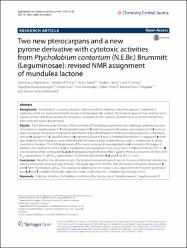Two new pterocarpans and a new pyrone derivative with cytotoxic activities from Ptycholobium contortum (NEBr.) Brummitt (Leguminosae): revised NMR assignment of mundulea lactone

View/
Access
info:eu-repo/semantics/openAccessDate
2016Author
Ngnintedo, DominiqueFotso, Ghislain W.
Kuete, Victor
Nana, Frederic
Sandjo, Louis P.
Karaosmanoğlu, Oğuzhan
Andrae-Marobela, Kerstin
Metadata
Show full item recordAbstract
Background: Ptycholobium is a genus related to Tephrosia which comprises only three species. Compared to Tephrosia, which has been phytochemically and pharmacologically studied, Ptycholobium species have only few or no reports on their chemical constituents. Moreover, no studies on the cytotoxic activities of its secondary metabolites have been previously documented. Results: From the non polar fractions of the roots bark of Ptycholobium contortum (syn Tephrosia contorta), two new pterocarpans: seputhecarpan C 1 and seputhecarpan D 2 and a new pyrone derivative, ptycholopyrone A 3 were isolated. Alongside, five known compounds identified as 3-alpha, alpha-dimethylallyl-4-methoxy-6-styryl-alpha-pyrone or mundulea lactone 4, glyasperin F 5, seputhecarpan A 6, seputheisoflavone 7 and 5-O-methyl-myo-inositol or sequoyitol 8 were also obtained. Their structures were established by the mean means of spectroscopic data in conjunction to those reported in literature. The NMR assignment of the major compound mundulea lactone 4 is revised in this paper. In addition, the cytotoxicity of the isolated metabolites was evaluated on two lung cancer cell lines A549 and SPC212. 8 was not active while compounds 1, 2, 4-7 displayed antiproliferative effects against the two carcinoma cell lines with IC50 values below 75 mu M. IC50 values below 10 mu M were obtained for 4, 6 and 7 on SPC212 cells. Conclusion: Based on the obtained results, Ptycholobium contortum turns to be a rich source of phenolic metabolites among them some bearing prenyl moieties. This study reports for the first time the isolation of pyrone derivatives 3 and 4 from Ptycholobium genus. The cytotoxicity observed for the isolate is also reported for the first time and shows that 4, 6 and 7 could be chemically explored in order to develop a hit candidate against lung cancer.

















